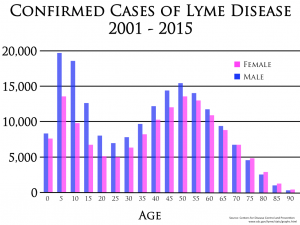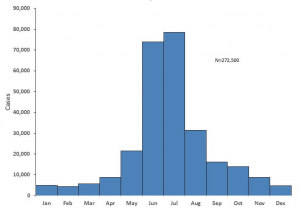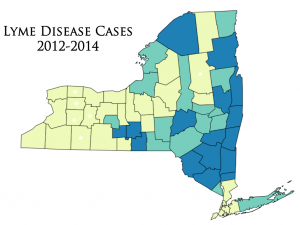By now, you’ve heard of Lyme disease. If you’re reading this in the Northeast, chances are you’ve had Lyme disease or know someone that does. And perhaps you know that Lyme disease is a topic entrenched in scientific and political controversy in terms of accurate diagnosis, effective treatment, and access to insurance. Putting these larger issues aside for the moment, the intent of this post is to present data on Lyme disease and help people to better understand the risks.
What: Lyme disease is a series of symptoms that occur when our body is infected with a bacterium called Borrelia burgdorferi. In the Northeast, the only way that people and animals become infected with Lyme is when they are bitten by a blacklegged tick – sometimes called the deer tick. The complex lifecycle of the tick and how they obtain and transmit pathogens is described by TickEncounter.

Who: Each year, approximately 30,000 cases of Lyme disease are reported to the CDC, making it the most commonly reported vector-borne disease in the US [a vector-borne disease is one transmitted through the bite of an organism such as a tick, mosquito, flea, etc.]. However, studies suggest that this number is only a fraction (about 10%) of the actual cases of Lyme disease in the US, putting the estimated number of cases between 300,000 and 400,000 each year. Based on this value, Lyme disease is the second most common infectious disease in the US, falling between two sexually transmitted diseases: Chlamydia (#1) and Gonorrhea (#3). Who is at the greatest risk of Lyme disease? Children! Especially boys aged 5 to 9 years old. Parents – check your children daily for ticks!!

When: Ticks can be active any day of the year when temperatures are above freezing. However, based on their lifecycle, the greatest risk of acquiring Lyme disease occurs during the spring months when nymph ticks are present, resulting in summer-time symptoms and doctor visits. Nymph ticks are about the size of a poppy seed, which makes them difficult to see. Check yourself daily for ticks, using your fingers to feel raised bumps and your eyes to notice new black marks.
Where: While Lyme disease is regarded as the second most common infectious disease in the entire US, over 96% of all cases come from only 14 states.
Fortunately, there are steps that individuals can take to reduce their risk of encountering ticks and acquiring tick-borne disease. These topics will be covered in a subsequent post.

